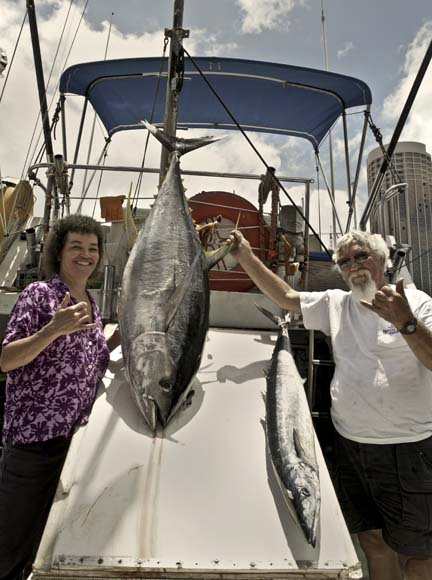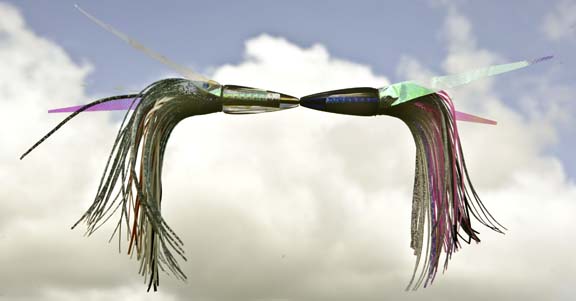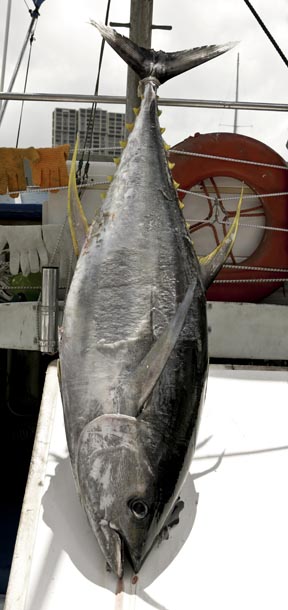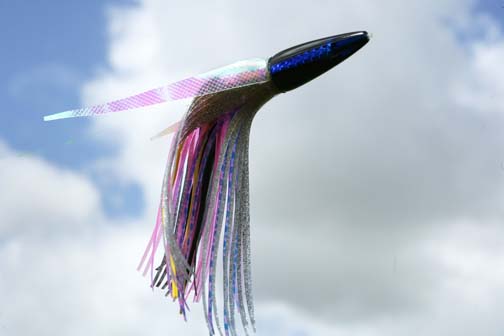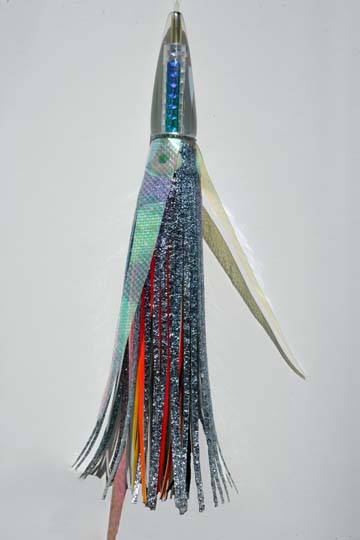AL BENTO GOT THE BLUES 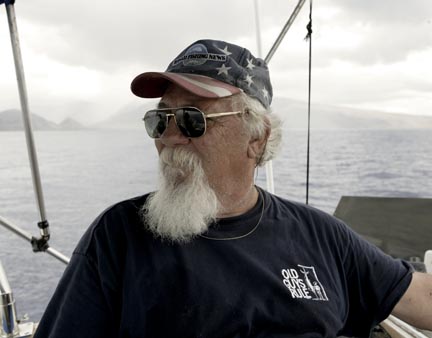
Ask any fisherman, or fisherwoman, how they got interested in fishing and they will tell you it was a grandfather, father, uncle, friend, or some other special person in their life who took them fishing. Generally that person taught them how to tie knots and flies, make lures, catch their own bait, bait the line, cast, and fine-tune the many secrets and idiosyncrasies we all use to locate and catch our fish. Some of us did not have the luxury of such a person in our lives, but those of us who did are indeed lucky. Unfortunately, we rarely hear a fishermen sing the praises of his or her mentor. Therefore, I would like to do so here.
Recently Kimberly Lowe and I had the distinct pleasure and good fortune to get to know one of our very own master fishermen while accompanying him on a fishing trip aboard his boat, the Alele II, a 35 foot Radon Sport Fisher. Besides being great company with his many stories, Al Bento passed on some tips and other information he learned over the years. As a result, Kimberly and Al pulled in a nice 170-pound yellow fin tuna or ahi. Every other minute he never ceased to amaze me. Prior to going on the trip he told us we would go to Waianae side and pick up a big ahi and then, on the way back, stop in the Pines and pick up a 30-40 lb. ono. That’s exactly what we did. After a few trolls we hooked the ahi. He then employed his infamous “spiral” method of bringing the ahi aboard. Next we went to Pines and hooked the 30 lb. ono. All in a day’s work!
|
|
Al’s Spiral Method for landing a hooked fish when using large dead fish for bait: “you make a wide turn with the boat and you will feel the pressure give. Repeat this maneuver over and over. As you are doing this you back down and take in some of the line. Line must be tight at all times. Don’t stop or the fish will sink again, increasing the pressure from the current and possibly causing you to lose the fish”.
As we worked on our fishing Al told us how, on one occasion, he was about 12 miles off Kamalapau, Lanai, when he found a deadhead tree about 100 ft. long with a base of about 18 feet. It was loaded with marlin, mahi, ono, and all types of tuna. The tree would go down for about 20 minutes then pop up, but was constantly moving. When down he would catch a few fish, but all hell broke loose when it resurfaced. He landed a couple thousand pounds of mixed fish. He fished that log for two days.
Al’s words of wisdom: “when you find a tree, troll it first. Once you stop catching with the troll you can bait the fish with dead bait, such as tuna, aku, squid and opelo.”
Kalaupapa, Molokai, is Al’s favorite spot and has produced some of his largest catches. In fact, Al told us that on May 12, 1994, he caught a Grander, a 1207 lb. Pacific Blue Marlin, in waters off Kalaupapa. At the time he was using one of his own custom, hand-made lures that he calls the “Silver Fox”.
Al has hand crafted several lures over the years and he showed us a couple. What beauties! He has one he calls “Ol’ Blu”. Al told us that in 1973, while raising his boys in Kona, nursing major back problems, and just putzing around for the fun of it, he carved his first lure from a dowel rod and made a mold of it. He wanted it to look like, and have the irresistible action of an Aku or skipjack. “Ol’ Blu” was here! Al found himself shaping, reshaping and modifying the weight of Ol’ Blu for all types of fish like Aku, Mahi mahi, Big eye tuna, Yellow fin tuna, Ono, Kawakawa, barracuda, Ulua, Uku and the rainbow runners that roam the waters off the Kona Coast and the rest of the Island of Hawaii, or Big Island.
|
Al has always, painstakingly, made his own lures. He told us that when he caught his record marlin he was using both Ol’ Blu and the Silver Fox in 25-knot winds, in 6 to 8 ft. seas. It “was a challenge” said Al. He did it by trolling with 200 feet on a short troll, with speeds of 7.6 - 8.3 knots. He used 400 lb. leader approximately 18 feet long. He was also using a 130 Penn international reel with 130 lb. test maxima IGFA certified line. The world record for the Pacific Blue Marlin is 1376 lbs. caught in Kona, Hawaii. He came close! As we continued fishing Al told us that “up to the time he caught his grander he didn’t know of any grander being caught with an over the counter lure”. “They lack the personal touch and catch history”, he said. That is why he makes his lures by hand and has never mass-produced them. “When made by hand your karma goes into each lure”. |
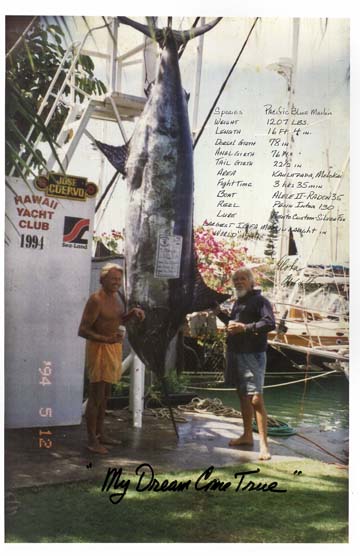 |
In 1990 Al made his first Silver Fox using the same mold he used for Ol’ Blu. The Silver Fox is lighter than Ol’ Blu. Also, Ol’ Blu is used on a short rigger, while the Silver Fox is to be used on a longer rig, good up to 12 knots. When using a Silver Fox Al recommends using 10-12-0 hooks. “If you are using a nine-inch skirt, use a 10-11-0 hook. If using a twelve inch skirt, use 12-0 hooks. Also, use 300 to 400 lb. leader with the lures”. Any line will do the job but he prefers Andy Leader line.
|
The Silver Fox and Old Blue |
Per Al, when you are trying for big fish, look for schools of bait fish. “When fishing for Tuna – troll around the edge of the school and stay on the perimeter.”
When trolling, Al runs four Penn 130’s and two Penn 50 rigs. 50’s are more for the smaller fish, but he has caught big marlin on them. When trolling the Silver Fox and Ol’ Blu, he always places them on opposite sides. “If you don’t see the lure, speed up or ring the lure in closer.”
MORE POINTERS FROM AL
When you leave the harbor you should be looking for an area where fish are reportedly being caught. To learn where these areas are you must talk with other fishermen and be willing to likewise share information. Get a chart to find out where the buoys are. Buoys, or fish aggregating devices, attract fish. But, keep in mind, there are times you won’t find fish around the buoys.
Weather is really not a factor unless it causes unsafe conditions. Otherwise, if conditions are good and safe, you should go out and look for signs like floating objects, birds, or current lines. If other fishing vessels are grouped together it usually means they have found fish.
When trolling, always have someone watching the lures in the water. The reason for this is, at any time you may see a fish come into your lure pattern. This gives you a better chance of hooking up a fish.
If the fish misses the lure, put the lure in free spool while thumbing the reel to avoid a “bird nest” or tangling of the line. Drop the lure back five to 10 counts. Then bring the lure back to the same spot it was originally at. Repeat this step a couple of times to keep the fish excited and interested, and biting again. Al has gotten fish to bite after the eighth or tenth time.
USE BIRDS AS YOUR GUIDE
When you see birds flying leisurely they are just looking. If you see birds flying a direct course it usually means that they are going to where other birds are feeding.
When seen in a flock that is moving and diving, there are definitely fish under them. When birds are diving you should always avoid driving through them. Stay on the outer edge of the fish and try to get your lures as close to the fish as possible without going through the center of the fish. Going through the fish will cause the school to break up, scatter and go down.
If you see white birds, mainly red red-footed boobies, diving but not entering the water, they are chasing malolo or flying fish. Most likely mahi mahi or other fish are around and pushing the malolo, or flying fish, to the surface.
When you see an ewa or frigate bird circling in one area, this usually means there are fish under it. If there are no other birds around, this usually means there could be a lone marlin underneath.
When you see an ewa or frigate bird up high, and it quickly dives to a lower elevation, this could mean the fish are up near the surface. The higher the ewa or frigate bird flies, the deeper the fish.
TAKE CARE OF YOUR FISH, AND YOURSELF
“We are all family and must put safety first, fishing second”.
Don’t waste your fish, care for it. Always carry enough rock salt and ice on your boat to make a brine to protect your fish from spoilage.
If a fish is too big for the cooler, lay the fish on a blanket or towel on the deck of the boat. Place towels on the fish soaked with water, and place bags of ice on top of fish to keep it cool.
Make sure you have safety gear, such as EPRB’s, a marine radio, a good emergency plan, and leave an itinerary with someone on shore. Trouble can pop up anytime. Also, you can never have too many fire extinguishers.
Have a decent pair of binoculars and a chart plotter. You can use the man overboard button to track floaters (net debris). Finally, buy a halfway decent fish finder / depth recorder.
This last year may have been one of the better years for fishing. The rising cost of fuel is prohibiting a lot of fishermen from going out as regularly as they used to. Al suggests that recreational fishermen pick and choose their trips, doing a mixture of trolling and bottom fish. Take some fish for kaukau.
|
KIM'S FISH - Caught by following Al's advise!
|
Al was born and raised in Waiehu Kahalui, Maui, Hawaii. He has bottom fished and dove all of the islands in Hawaii so he really knows his stuff! And, he is usually the first guy to go to tow or aid a fellow fisherman when in trouble. This even applies when participating in tournaments!
At the Hawaii Yacht Club Al helped found the annual Senoritas, Goodwill, Ho’olea and Keiki fishing tournaments. These are among the most popular events hosted by the Club. Al has also fished in and served as a commissioner in the Hawaiian International Bill Fish Tournament. He is currently an International Game Fish Association Representative, which allows him to certify world records.
When not fishing you can find Al at the Hawaii Yacht Club sharing his wealth of knowledge with other fishermen. So drop Al a line or give him a call and chat a while. Al does not conduct chartered trips out of the Ala Wai Harbor but he is always willing to accompany you on your boat to share his expertise. If you are interested in purchasing lures from Al or just have a question for him. You can reach him by phone at 808-223-8210 or email him at bentocustomlures@gmail.com
|
HAPPY FISHING ! |
|
Old Blue |
The Silver Fox
|
